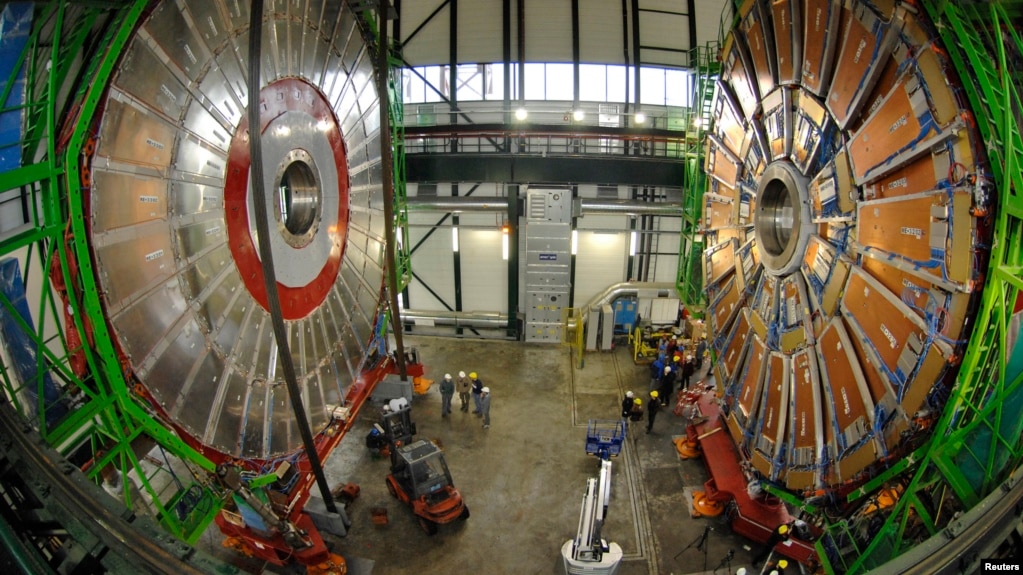反物質の謎
トム・ハンクスさん主演の映画「天使と悪魔」、憶えていらっしゃいますか?
その「天使と悪魔」の舞台の一つとして、LHCを建設したCERN、欧州原子核研究機構が登場していました。CERNの研究者が作り出した反物質をめぐって、バチカン市国を駆けまわる……たしかそんなお話だったようなと思いながら、聞いた今回のVOAニュース。
E=mc² からつながる反物質の世界へどうぞ!!
- 巨大な機械が宇宙の最小ピースを探す
- 反物質とはーmatter anti-matter
- 私たちの存在
- 反物質で宇宙旅行
- 原文 Huge Machines Search for Smallest Pieces of Universe
巨大な機械が宇宙の最小ピースを探す
Huge Machines Search for Smallest Pieces of Universe
反物質として知られているこの珍しい物質は、宇宙や未来をテーマにした多くの映画に登場したことがあるかもしれません。
しかし、欧州原子核研究機構(European Organization for Nuclear Research: CERN)では、実際の科学者たちがほぼ毎日研究を行っています。彼らの研究は、宇宙が何でできているのか、そして宇宙がどのように機能しているのかを解明するための一環です。
スイスのジュネーブに拠点を置くCERNには、23カ国の加盟国があり、さらに多くの国の科学者や職員が働いています。
CERNの研究所は、リング状の地下構造物です。全長27キロで、スイスとフランスの国境を越えています。
その中に大型ハドロン衝突型加速器があります。この巨大な機械の中では、陽子と呼ばれる原子の一部が非常に強い力でぶつかり合うように作られています。これにより、反物質などの元素が生成されるのです。
しかし、物理学者が反物質を作れるからといって、反物質のすべてを理解しているわけではありません。反物質は宇宙と同じくらい古いもので、”ビッグバン”と呼ばれる出来事で創造された物の一部です。
ルディヴィン・セアド氏はCERNの物理学者です。彼女は研究の背後にある理論の一つについて話してくれました。
「私たちは、ビッグバンの直後に、物質と反物質の間に等量の創造があったという理論を持っています。」と彼女はVOAに話してくれました。「もし2つの間の違いが電荷だけであるならば、それらは再結合し、放射線以外の何も残されていないはずなのです。」
「しかし、我々はここにいる...ということは、ある時点で物質が反物質を引き継いだということになるのです。」と付け加えました。
このことは、物質と反物質の間にはまだ知られていない違いがあることを示している、とセアド氏は言います。
これらの違いを探すことが、人々がコンパクトミュオンソレノイド(CMS)でする仕事の一つなのです。CMSは、CERNの大型ハドロン衝突型加速器の周辺にある4つの主要な実験施設の1つです。
ミュオンは、いわゆる素粒子の一つで、小さい部分がない粒子です。ミューオンは電子に似ていますが、より重いのです。また、非常に小さいのですが、それを研究するために作られた機械は非常に大きいのです。
ミューオンや反物質を作るためには、陽子のグループが円形の構造物の周りを2本のビームで競い合い、ほぼ光速で反対方向に移動します。物理学者の準備が整うと、ビームは焦点を合わせられ、ちょうど良い場所でお互いにぶつかるように作られます。
レンデ・ステレンバーグ氏は、この衝突を見るグループのリーダーです。「実験のどちらか一方の端で、集束用の磁石のスイッチを入れて、ビームを押し込むようにします」と彼は言います。
そうすることで、ビーム同士がぶつかる可能性が高くなります。
1,000億個の陽子が一方の方向に移動し、1,000億個の陽子がもう一方の方向に移動したとしても、陽子同士がつながる可能性は50個しかありません。
しかし、今は衝突の可能性はゼロです。それは、機械とその周りの実験が、修理や改良のために2年間の作業休止中だからです。これは3年に1回のペースで行われます。
しかし、まだまだやるべきことはたくさんあります。
CMSプロジェクトには、50カ国以上から約4,000人の科学者が参加しています。パトリシア・マクブリッジ氏は、CMSプロジェクトの代表者です。彼女によると、今回の活動停止は科学者が自由な時間を得られることを意味するものではないといいます。
「私たちにとってはチャンスと言ってもいいでしょう。私たちは検出器の改良、修理、新しい検出器の設置、そして2035年までの将来の運用に向けての準備をしています。」と彼女は言います。
反物質とはーmatter anti-matter
始まりは、原爆と原発をつくりだした方程式 E=mc²
Eはエネルギー、mは質量、cは光速度。
物質(物体)が運動して光の速度に近づけば、そのエネルギーはだんだん最大に向かっていく。科学的にいえば「質量はエネルギーに変わりうる」となり、さらにはっきりいえば「質量には膨大なエネルギーが閉じ込められている」というふうになる。(☟要約)
世界で最も美しくて最も恐ろしい方程式 アインシュタインが生み出した原爆と原発の原理 松岡正剛 (2/6ページ) - SankeiBiz(サンケイビズ)
もともとアインシュタインの相対性理論のエネルギーに係わる計算を色々な形でやり直していたポール・ディラックという学者が、エネルギーの式に2乗が含まれていたことから、最終的な答えにはプラスとマイナスがあると言いだしたことがきっかけで、この世のすべての粒子(電子、陽子など)には物理的条件が1つだけの正反対の粒子(反粒子)が存在すると予測されたのです。
最初の反粒子の発見は宇宙から地球に降り注ぐ放射線(宇宙線)の測定中に発見されました。
ただ反粒子は一般的に非常に不安定ですぐ別の粒子に変化していまします。そのため反粒子だけ集まった通常我々が物質と呼んでいるような固まりの状態では存在しません。
物質の最小単位は素粒子で、一般的に粒子と反粒子が対として存在します
粒子によって構成された「物質」でできています。反粒子によって構成されたものは、「反物質」と呼びます。
1932年、カリフォルニア工科大学の物理学者アンダーソンは世界で初めて反粒子を検出したそうです。
私たちの存在
反物質で宇宙旅行
NASAの研究チームが、反物質エンジンは数十年以内に実現できるとする論文を『Journal of Propulsion and Power』誌に発表した。これは、宇宙探査の究極の目的である恒星間航行の実現に向けた重要な一歩である。☟
原文 Huge Machines Search for Smallest Pieces of Universe
 FILE - Overview of the first element (L) of the huge magnet of the CMS (Compact Muon Solenoid) experimental site at the European Organization for Nuclear Research CERN (Centre Europeen de Recherche Nucleaire) before its lowering on Thursday in the French village of Cessy in 2006
FILE - Overview of the first element (L) of the huge magnet of the CMS (Compact Muon Solenoid) experimental site at the European Organization for Nuclear Research CERN (Centre Europeen de Recherche Nucleaire) before its lowering on Thursday in the French village of Cessy in 2006
The unusual substance known as antimatter may have appeared in many films about space and the future.
But it is what real scientists at the European Organization for Nuclear Research, or CERN, work on almost every day. Their research is part of efforts to find out what the universe is made of -- and how it works.
Based in Geneva, Switzerland, CERN has 23 member nations and includes scientists and other employees from many more countries.
Their research laboratory is a ring-shaped underground structure. It is 27 kilometers around and crosses the border between Switzerland and France.
In the structure lies the Large Hadron Collider. In this huge machine, the parts of atoms called protons are made to crash into one another with extreme force. This creates antimatter and other elements.
But just because physicists can make antimatter does not mean they understand everything about it. Antimatter is as old as the universe. It is part of its creation, in an event often called the “Big Bang.”
Ludivine Ceard is a physicist with CERN. She discussed one of the theories behind the research.
“We have this theory that says that right after the Big Bang, there was creation in equal amount between matter and antimatter,” she told VOA. “If the difference between the two is only the charge, they should have just recombined and left nothing but radiation.”
Ceard added, “However, we are here…So it means at some point, matter took over the antimatter.”
This, Ceard said, shows scientists that there are differences between matter and antimatter that they do not yet know.
Searching for those differences is one of the tasks for the people at the Compact Muon Solenoid, or CMS. That is one of four main experiment sites around the Large Hadron Collider at CERN.
A muon is one of the so-called elementary particles, one with no smaller parts. It is similar to an electron, but heavier. And although it is extremely small, the machine built to study it is very large.
To create muons and antimatter, groups of protons race around a circular structure in two beams, moving in opposite directions at almost the speed of light. When the physicists are ready, the beams are focused and made to hit each other in just the right place.
Rende Steerenberg leads the group in charge of seeing those crashes happen. “On either end of the experiments we will switch on focusing magnets so that the beam squeezes,” he said.
This increases the chances of the beams hitting each other.
Even with 100 billion protons in a group moving in one direction and 100 billion protons moving the other way, only 50 protons are likely to connect.
Right now, however, the chance of a collision is zero. That is because the machine and the experiments around it are in the middle of a two-year work suspension for repairs and improvements. This happens every three years.
But there is still plenty of work to do.
The CMS project includes about 4,000 scientists from more than 50 countries. Patricia McBridge is a representative of the CMS project. She said the suspension does not mean scientists get free time.
“I would say that for us it’s an opportunity,” she said. “We’re looking at ways of making the detector better, repairing things, putting in new detectors, and preparing for the future runs which … will be running until, we hope…2035.”
_______________________________________________________________
Words in This Story
antimatter – n. molecules formed by atoms consisting of antiprotons, antineutrons, and positrons
ring – n. something that is shaped like a circle
proton(s) – n. a very small particle of matter that is part of the nucleus of an atom and that has a positive electrical charge
site(s) – n. a place that is used for a particular activity
electron – n. a very small particle of matter that has a negative charge of electricity and that travels around the nucleus of an atom
beam(s) – n. a line of energy or particles that cannot be seen
focus(ed) – v. to cause something, such as attention, to be directed at something specific
squeeze(s) – v. to press together the parts and especially the opposite sides of something
opportunity – n. an amount of time or a situation in which something can be done
We want to hear from you. Write to us in the Comments Section.